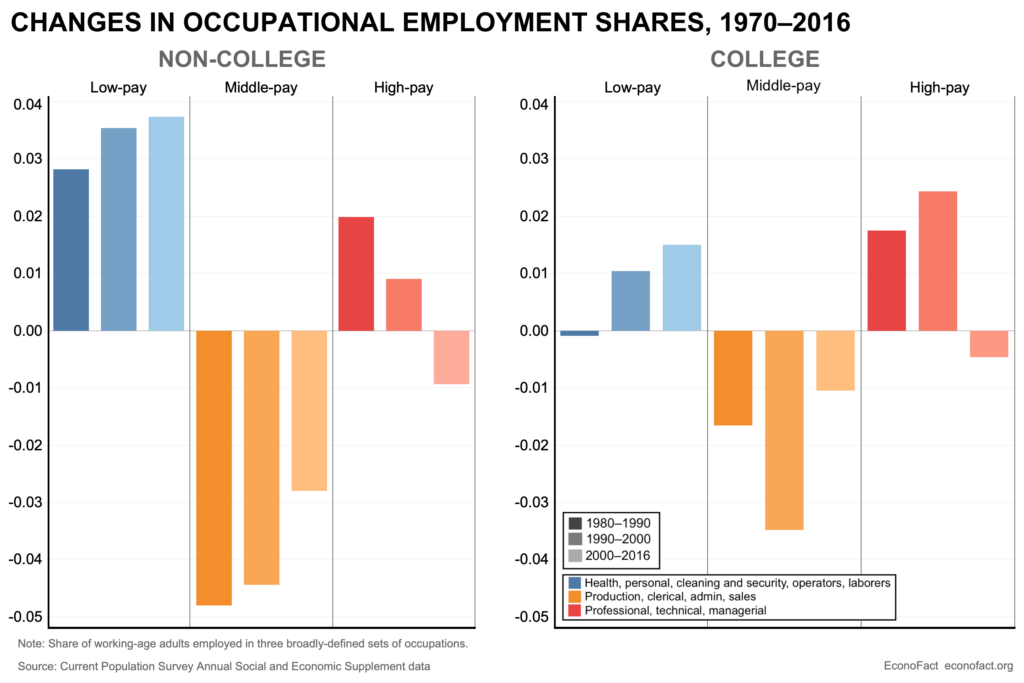Tuesday, March 15, 2022
The Shrinking Share of Middle-Income Jobs
From EconoFact:
“The Issue:
Over the past four decades, less-educated workers, particularly non-college men, have experienced an actual fall in their real earnings (that is, after adjusting for inflation). An important reason for this decline in the earnings among low-income workers is the shifting structure of occupations, with a hollowing-out of what had been middle-income jobs. This is especially true in urban and metropolitan areas, places where there had been good job opportunities for those without a college education but, increasingly, the jobs available to those with a high school education in these places are in low-paid occupations with little opportunity for upward mobility.
The Facts:
- Rising wage inequality is a well-documented characteristic of the U.S. labor market over the past 40 years; but such divergence in earnings was not a feature of the preceding decades. The post-World War II period can be divided into three eras with respect to the distribution of wages. The period from immediately after World War II until 1972 was a time when wages were rising evenly for people with all levels of education. In contrast, the period that began with the first oil shock in 1973 through the end of the 1970s saw inflation-adjusted earnings stagnate across the board. Subsequently, beginning in 1980 and continuing to the present there has been rising wage inequality, with wages rising robustly for the most educated and falling, in real terms, for the least educated. This is especially striking because the supply of highly-educated workers has increased while that of less-educated workers has declined; the share of hours worked by those without a college degree fell from 75 percent in 1963 to less than 40 percent in 2017 while over the same period the share of hours worked by those with a bachelor’s or post-college degree rose from less than 15 percent to more than 35 percent.
- An important source of these shifts in wages and hours is the hollowing out of middle-income jobs. While there are a range of reasons for the decline in wages and hours worked for those with less than a college education (including eroding union power, rising trade in manufacturing goods from low-labor-cost countries, and falling real values of minimum wages), an important reason that has not had as much attention is the decline in jobs that had provided middle-class wages for those with less than a college education. The shrinking share of these middle-income jobs appears as a “barbell effect” with the decline of middle-paid jobs contrasted by the rise in the employment share for both lower- and higher-paid jobs (see chart). Employment can be sorted into three broadly defined sets of occupations: those with typically low pay and education requirements that require little specialized skills or training (health aids and personal services, cleaning and security, and operators and laborers); middle-paid occupations that do not necessarily demand a four-year college degree but do require specialized skills (production workers, office/administrative workers, and sales workers); and high-paid occupations that typically require a four-year degree (technicians, professionals, and managers). In 1980, non-college workers were evenly split between low- and medium-paid occupations (at 42 percent and 43 percent, respectively) and the remaining one-seventh of workers without college degrees were in traditionally high-paid occupations. By 2016, the share of non-college educated workers in mid-pay occupations had fallen to 29 percent, with about 12 of the overall 14 percentage point decline representing a shift to the low-paid category and less than a 1.5 percentage point increase in the high-pay category. Over this same period, there was a more modest barbell effect for college-educated workers, with those in the mid-pay occupations declining from 27 to 20 percent, those in high-pay occupations rising from 57 to 61 percent, and those in low-paying occupations rising from 16 to 19 percent.
- There are technological, global and institutional reasons why this “barbell effect” was concentrated among workers in urban and metropolitan areas. In the 1950s and 1960s, workers in urban areas who did not have college degrees disproportionately held middle-education, middle-income, blue-collar production jobs and white-collar office, administrative and clerical jobs as compared to workers in suburban and rural areas. These jobs involved close collaboration with more highly-educated professional, managerial and technical workers who oversaw factories and offices. This collaboration benefited workers holding these middle-income jobs since their value to their companies was enhanced by high-education coworkers. But starting in the 1970s, the demand for mid-education urban workers declined due to rising automation in factories, greater use of computers and information technology in offices, and greater pressure from international trade. Workers without a college degree moved from middle-income occupations to those that traditionally require less education and offer lower wages – and because middle-income jobs for those without a college degree were more prevalent in urban and metropolitan areas, this had a proportionally bigger effect in those places. “

Continue reading here.
Posted by at 7:22 PM
Labels: Macro Demystified
Subscribe to: Posts